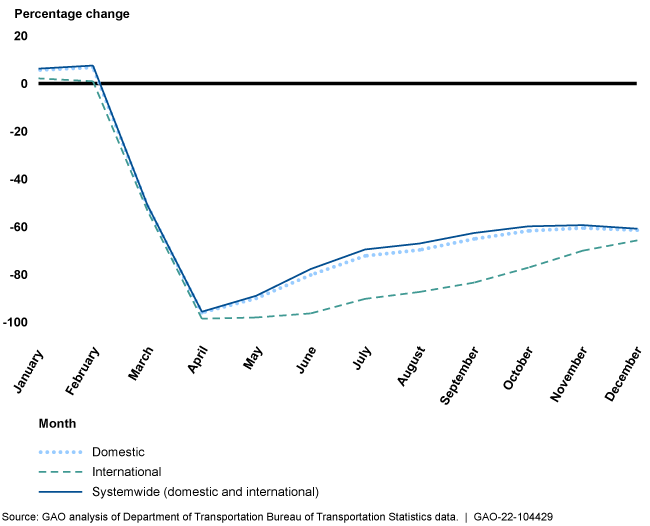COVID-19 Pandemic: Observations on the Ongoing Recovery of the Aviation Industry
Fast Facts
The COVID-19 pandemic had a profound impact on the U.S. aviation industry. Passenger traffic in April 2020 was 96% lower than April 2019, and stayed 60% below 2019 levels in 2020. Effects cascaded across airports, repair shops, and the supply chain. For example, in response to reduced demand, airlines parked or retired many aircraft, which reduced demand for maintenance.
Stakeholders noted the importance of over $100 billion in federal assistance for payrolls, rents, and more. FAA actions included temporary relief from some regulatory requirements.
We continue to recommend development of a U.S. aviation preparedness plan for disease threats.
U.S. Airline Passenger Traffic, Percentage Change 2019 versus 2020

Highlights
What GAO Found
The COVID-19 pandemic severely affected the aviation and aerospace sectors that depend on commercial passenger travel. As demand for air travel plummeted and remained low throughout 2020, effects cascaded across sectors including U.S. passenger airlines, airports, aviation manufacturers, and repair station operators. For example, in response to reduced demand, airlines parked or retired a substantial portion of their aircraft fleet, which, in turn, reduced demand for aircraft maintenance services.
Aircraft Temporarily Stored at Denver International Airport in 2020

In response to the pandemic's effects, aviation stakeholders reported that they acted quickly to mitigate financial losses and position themselves to maintain business viability until demand increased. Stakeholders' actions included:
- managing costs, such as by implementing early retirement programs;
- raising funds in the private market to increase liquidity; and
- taking steps to mitigate COVID-19's spread among employees and customers.
Stakeholders also noted the importance of the over $100 billion in payroll support payments, loans, and other financial assistance provided through COVID-19 relief legislation.
The Federal Aviation Administration (FAA) reported taking quick action to help the aviation industry adjust operations in response to the pandemic. These actions included providing temporary relief from some regulatory requirements—such as airline crewmember medical certifications—and issuing guidance to airlines and airports on mitigating COVID-19 risks. FAA has phased out many of these relief measures.
Although airlines experienced a rebound in demand for U.S. leisure travel in 2021, operational challenges and concerns about the COVID-19 Delta variant have slowed recovery. Forecasts suggest that industry recovery will be uneven as business and international air travel—the most profitable segments—are likely to lag. Stakeholders identified areas of concern for policymakers to consider, such as strengthening aviation workforce pipelines, as they determine how or whether to continue to assist the industry in evolving market conditions. Further, developing a national aviation-preparedness plan for communicable disease, as GAO recommended, would provide greater coordination among federal and industry stakeholders and help better prepare the U.S. for future pandemics.
Why GAO Did This Study
International flight restrictions, local stay-at-home orders, and a general fear of contracting and spreading COVID-19 through air travel had a sudden and profound effect on the U.S. aviation industry. According to Department of Transportation (DOT) statistics, passenger traffic in April 2020 was 96 percent lower system-wide than April 2019, and remained 60 percent below 2019 traffic levels throughout 2020.
This report examines (1) immediate effects of the COVID-19 pandemic on businesses across the aviation industry; (2) actions those businesses took in response; (3) actions the FAA took to help the industry respond to the pandemic; and (4) the outlook for industry recovery, among other issues.
GAO reviewed DOT airline operational and financial data from calendar years 2019 through 2020, financial statements from various aviation-related businesses, FAA regulations and operational guidance, and industry recovery forecasts. GAO conducted a generalizable survey of 1,136 smaller airports. GAO also interviewed officials from FAA and representatives from a judgmental sample of 47 aviation and aerospace industry stakeholders selected based on location and industry sector.
Recommendations
GAO continues to urge Congress to take legislative action to require DOT to work with relevant agencies, stakeholders, and members of the aviation and public health sectors to develop a national aviation-preparedness plan for communicable disease threats.
